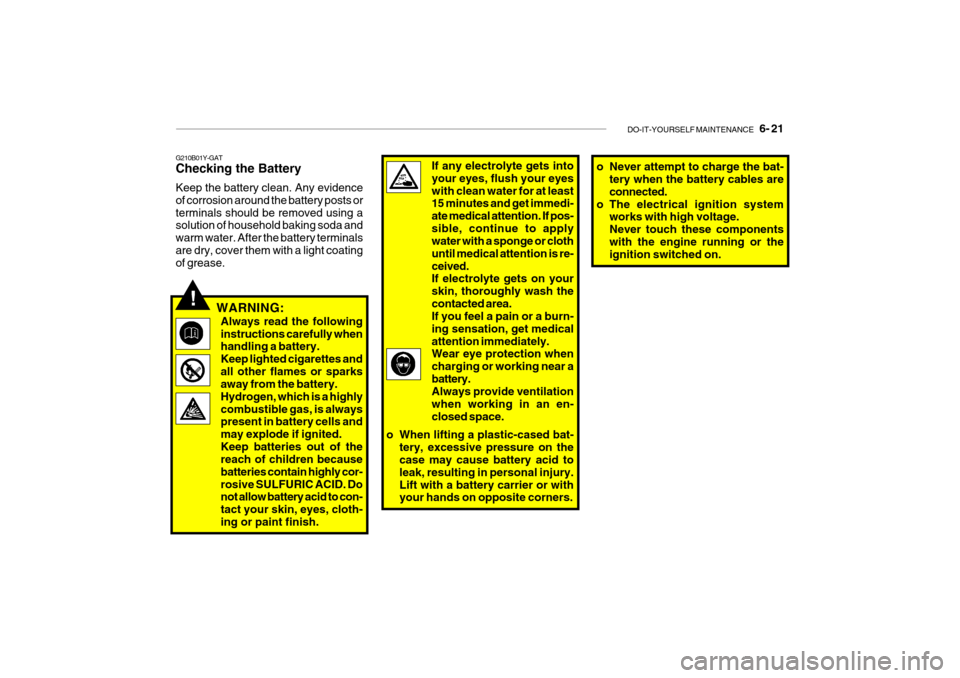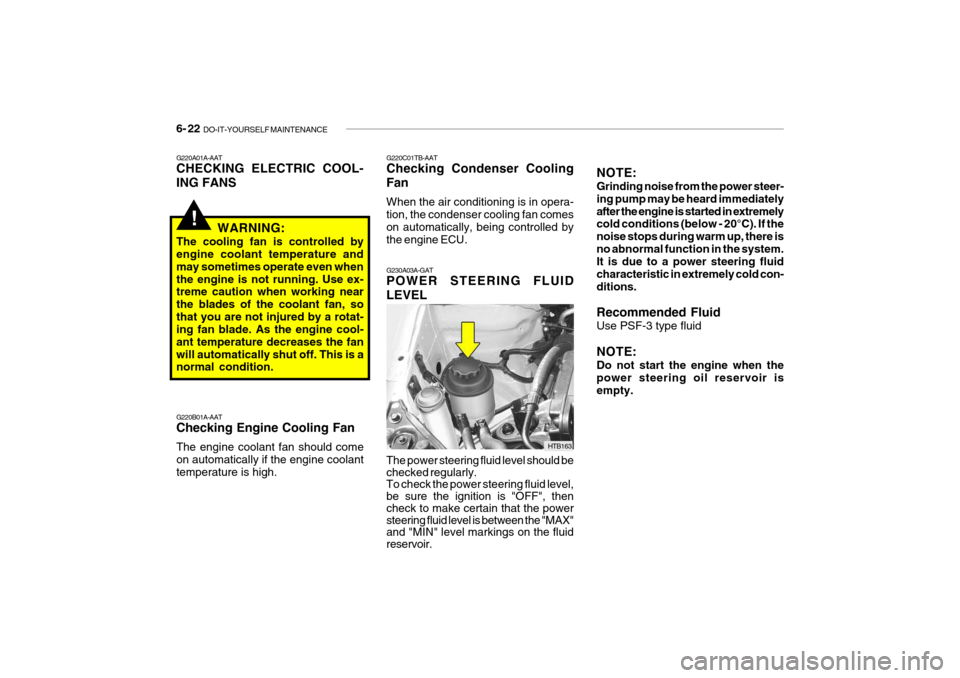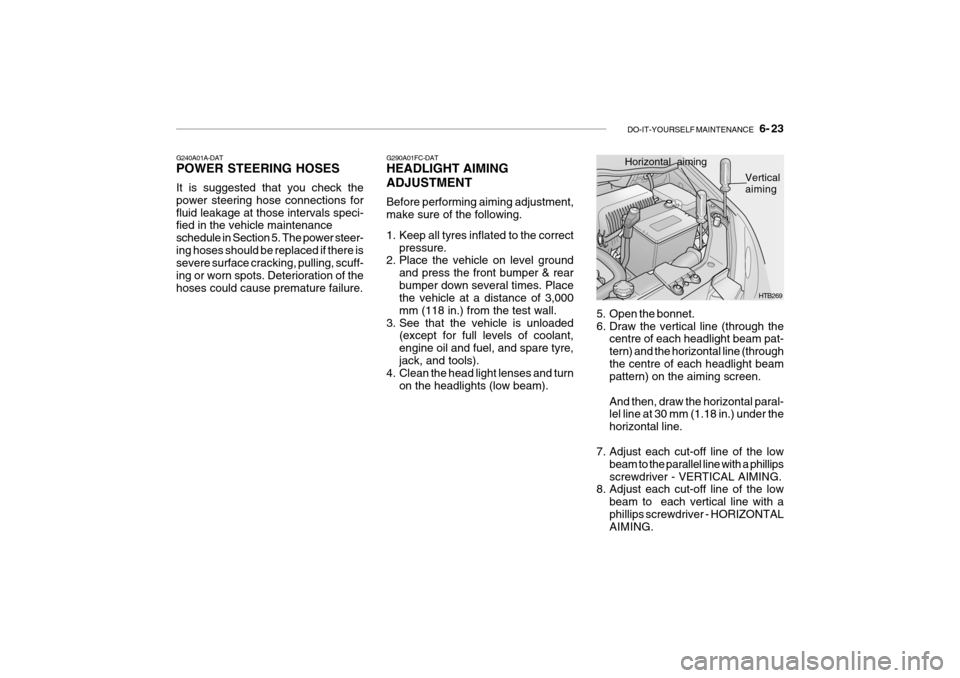Page 163 of 191

DO-IT-YOURSELF MAINTENANCE 6- 21
If any electrolyte gets into your eyes, flush your eyeswith clean water for at least 15 minutes and get immedi- ate medical attention. If pos-sible, continue to apply water with a sponge or cloth until medical attention is re-ceived. If electrolyte gets on your skin, thoroughly wash thecontacted area. If you feel a pain or a burn- ing sensation, get medicalattention immediately. Wear eye protection when charging or working near abattery. Always provide ventilation when working in an en-closed space.
o When lifting a plastic-cased bat- tery, excessive pressure on the case may cause battery acid to leak, resulting in personal injury.Lift with a battery carrier or with your hands on opposite corners.
!
G210B01Y-GAT Checking the Battery Keep the battery clean. Any evidence of corrosion around the battery posts orterminals should be removed using a solution of household baking soda and warm water. After the battery terminalsare dry, cover them with a light coating of grease.
WARNING:
Always read the following instructions carefully when handling a battery. Keep lighted cigarettes andall other flames or sparks away from the battery. Hydrogen, which is a highlycombustible gas, is always present in battery cells and may explode if ignited.Keep batteries out of the reach of children because batteries contain highly cor-rosive SULFURIC ACID. Do not allow battery acid to con- tact your skin, eyes, cloth-ing or paint finish. o Never attempt to charge the bat-
tery when the battery cables areconnected.
o The electrical ignition system works with high voltage.Never touch these componentswith the engine running or the ignition switched on.
Page 164 of 191

6- 22 DO-IT-YOURSELF MAINTENANCE
G230A03A-GAT POWER STEERING FLUID LEVEL The power steering fluid level should be checked regularly. To check the power steering fluid level, be sure the ignition is "OFF", then check to make certain that the power steering fluid level is between the "MAX" and "MIN" level markings on the fluid reservoir. HTB163NOTE: Grinding noise from the power steer- ing pump may be heard immediatelyafter the engine is started in extremely cold conditions (below - 20°C). If the noise stops during warm up, there isno abnormal function in the system. It is due to a power steering fluid characteristic in extremely cold con-ditions. Recommended Fluid Use PSF-3 type fluid NOTE: Do not start the engine when the power steering oil reservoir is empty.
!
G220A01A-AAT CHECKING ELECTRIC COOL- ING FANS
WARNING:
The cooling fan is controlled by engine coolant temperature and may sometimes operate even whenthe engine is not running. Use ex- treme caution when working near the blades of the coolant fan, sothat you are not injured by a rotat- ing fan blade. As the engine cool- ant temperature decreases the fanwill automatically shut off. This is a normal condition. G220B01A-AAT Checking Engine Cooling Fan The engine coolant fan should come on automatically if the engine coolanttemperature is high. G220C01TB-AAT Checking Condenser Cooling Fan When the air conditioning is in opera- tion, the condenser cooling fan comes on automatically, being controlled by
the engine ECU.
Page 165 of 191

DO-IT-YOURSELF MAINTENANCE 6- 23
G290A01FC-DAT HEADLIGHT AIMING ADJUSTMENT Before performing aiming adjustment, make sure of the following.
1. Keep all tyres inflated to the correct
pressure.
2. Place the vehicle on level ground
and press the front bumper & rear bumper down several times. Place the vehicle at a distance of 3,000 mm (118 in.) from the test wall.
3. See that the vehicle is unloaded (except for full levels of coolant,engine oil and fuel, and spare tyre,jack, and tools).
4. Clean the head light lenses and turn
on the headlights (low beam).
G240A01A-DAT POWER STEERING HOSES It is suggested that you check the power steering hose connections forfluid leakage at those intervals speci- fied in the vehicle maintenance schedule in Section 5. The power steer-ing hoses should be replaced if there is severe surface cracking, pulling, scuff- ing or worn spots. Deterioration of thehoses could cause premature failure.
HTB269
Horizontal aiming
Vertical
aiming
5. Open the bonnet.
6. Draw the vertical line (through the centre of each headlight beam pat-tern) and the horizontal line (throughthe centre of each headlight beam pattern) on the aiming screen. And then, draw the horizontal paral- lel line at 30 mm (1.18 in.) under the horizontal line.
7. Adjust each cut-off line of the low beam to the parallel line with a phillipsscrewdriver - VERTICAL AIMING.
8. Adjust each cut-off line of the low
beam to each vertical line with aphillips screwdriver - HORIZONTAL AIMING.
Page 189 of 191

INDEX 10- 3
Drink Holder ................................................................ 1-54
Drive Belts .................................................................. 6-18
Driving Economical driving .................................................. 2-14
Smooth corneri ng ..................................................... 2-15
Winter driving ........................................................... 2-15
E Emission Contro l System ............................................ 7-2
Engine Before starting the engine ........................................ 2-3Compartment ............................................................ 6-2
Coolant ..................................................................... 6-6
Coolant temperature Indicator ..................................1-41
If the engine overheats ............................................. 3-4
Number ..................................................................... 8-2
Oil ............................................................................. 6-4Starting ..................................................................... 2-4
Engine Exhaust Can Be Dangerous ............................ 2-2
F
Fan Speed Control ...................................................... 1-72
Fog Light
Front ........................................................................ 1-51
Front Seats Adjustable front seats .............................................. 1-12Adjustable headrests
............................................... 1-13
Adjusting seat forward and rearward ........................1-12
Adjusting seatback angle .. ......................................1-12
Lumbar support control ............................................ 1-14
Seat cushion height adjustment .............................. 1-14
Fuel
Capacity ................................................................... 9-2
Gauge ...................................................................... 1-41
recommendations ...................................................... 1-2
Fuel Filler Lid Remote release ....................................................... 1-63
Fuses ......................................................................... 6-18
Fuse panel Description ............................................... 6-30
GGeneral Checks ........................................................... 6-4
Glove Box .................................................................. 1-58
H Hand Brake ................................................................. 1-61
Hazard Warning System ............................................. 1-50
Headlight Aiming Adjustment...................................... 6-23
Heating and Cooling Control .......................................1-71
Air flow control ......................................................... 1-73
Air intake control ..................................................... 1-73
Bi-level heati ng ........................................................ 1-76
Fan speed control .................................................... 1-72
Temperature control ................................................. 1-75